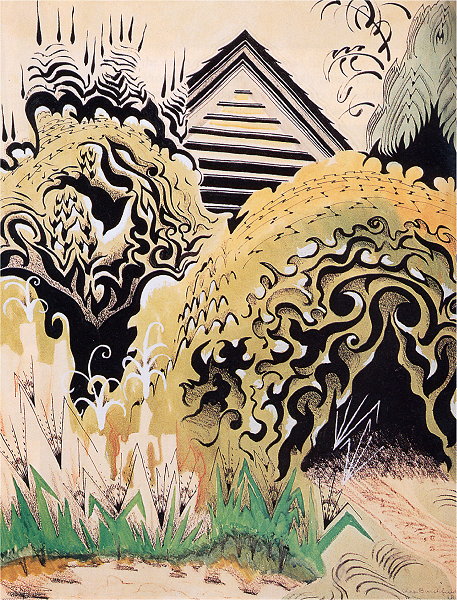
Charles Burchfield (1893-1967)
An American painter, best known for his watercolor landscapes. bio/background | video | bio | bio/works
The Insect Chorus (1917)
Opaque and transparent watercolor with ink, graphite, and crayon on off-white paper.
Munson-Williams-Proctor Arts Institute, Museum of Art, Utica, New York. ( siris comments )
(look for elements and traits that repeatedly appear)
Pattern, pattern and more irregular, bold and playful pattern. There are several regions in the composition, each has its own kind of pattern of repeating marks or shapes. It is as though each of the summer-night insects creates its own sound, echoed here visually by the rhythms of a distinctive pattern.
Color is generally quite subdued and limited — the pale yellow and muted green work along with black and white. That's a very limited palette, which will serve to simplify and unify the composition.
Value contrast is generally rather high — lights and darks are juxtaposed throughout most of the patterns, creating a noisy, busy, cacophony of pattern. In effect, the bold pattern expresses just how loud the night-time insect chorus can be.
Space is generally flattened into only a shallow stage. Each area of pattern is, itself, quite flat. But the areas each overlap each other, creating that shallow space. It is as though there are several vertical panels on a stage, set just inches in front of one another.
This shallow space and general flatness tends to unify and simplify the compostion.
(look for alignments, structures or groupings that organize parts into larger entities (gestalt))
This composition is not tightly or rigidly ordered — its more nearly about the chaos of nature's noises. Thus, there are several irregularly placed groupings of patterns. These groupings or clusters do help to simplify the overall business, thus unifying the composition.
(look for dominances — which traits or elements are prominent throughout the composition?)
Color: Pale yellow
Contrast: rather bold value contrast
Texture: most edges are clean, sharp and smooth. Shapes are generally of a single, solid color. Some textural variation occurs, especially around the grass in the lower left.
Shapes: Circular/Oval shapes and curves are positioned throughout Degas' composition. All other shapes/objects are subdued. The hats — objects that are, here, oval shaped — seem sometimes to suspend in space — their supports being much less prominent than the hats themselves.
(look for contrast of any and every kind. Look especially for similar forms that are varied in some way. Look for anomalies — patterns or norms that are broken.)
The many patterns are never completely consistent or the same — they continually vary, creating a sort of ongoing play on pattern.
Balance: There is a comfortable assymetry at work...none too rigid, but neither is it particularly dramatic.
Contrast: as noted elsewhere, the image has a lot of bold value contrast among its patterns.
Describe the forms that contribute to their graphic emphasis?
(do you see any anomalies to the norm/dominances?)
(are there any directional cues pointing/leading to areas of interest?)
Note the gradients or "chreschendos" among the patterns — several build up from lighter areas of delicate features, to areas of bold-dark shape on light.
(central position in the composition? rule-of-1/3s positions?)
(heightened contrasts? ...heightened detail/complexity? )
In two or three areas, the patterns and contrasts build up more forcefully than elsewhere.
(do forms frame or surround any focal areas? has isolation "enveloped" any relief areas?)
This image is mostly "about" the loud and busy sounds of night-time insects, so genuine calm and relief is not happening much here. There are areas at the top and bottom of the compostion that are basically calm and static relief. There are also variations in the degree of contrast and busyness — surrounding the more intense, focal areas, there are areas of somewhat subdued busyness.